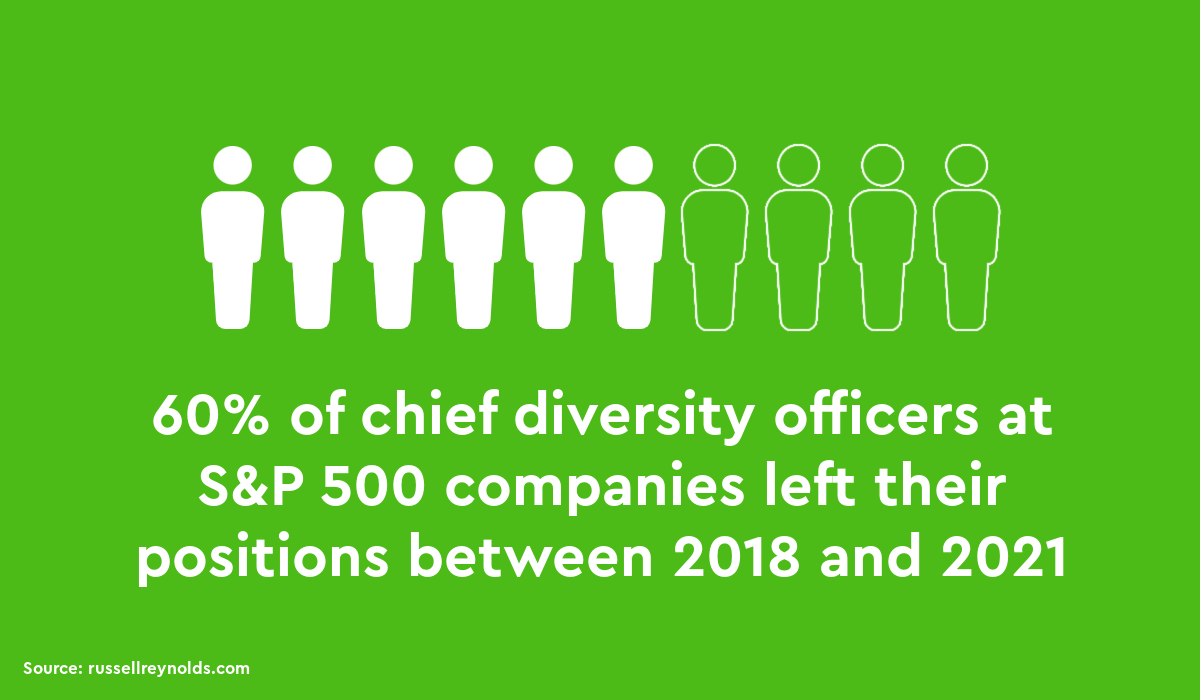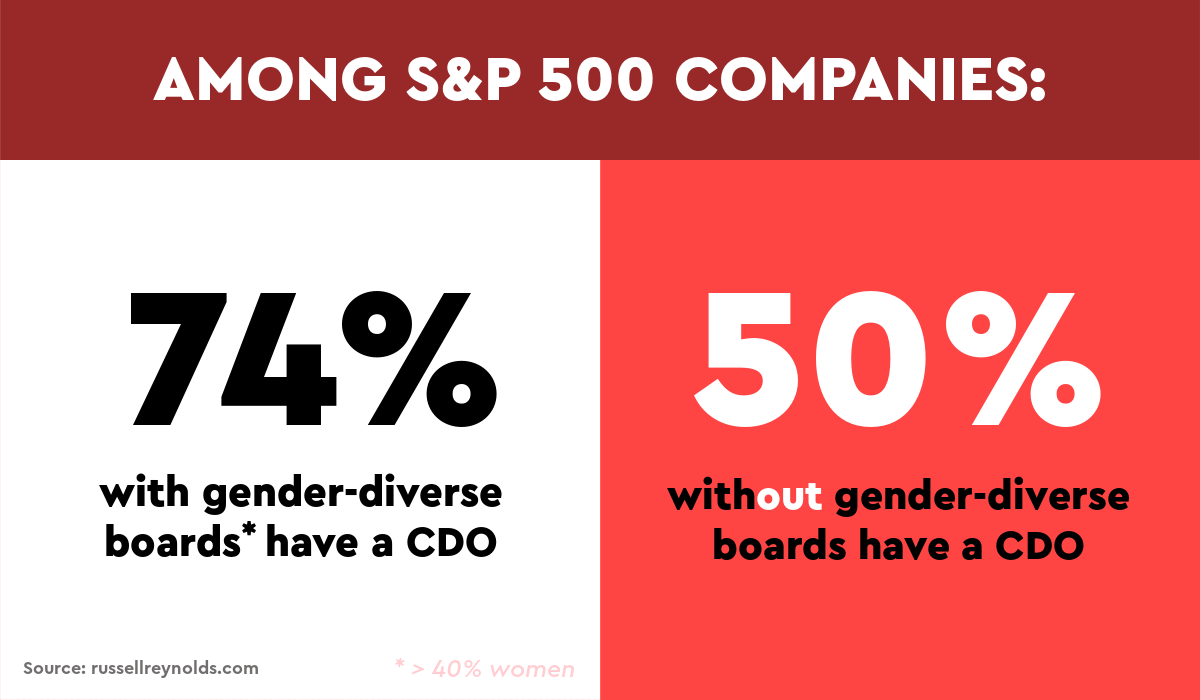Were Chief Diversity Officers Set Up to Fail? Recent Exits Indicate This Could Be the Case
Were chief diversity officers set up to fail? Facing burnout and a lack of executive support, many DEI leaders have quit.

Tesla CEO Elon Musk has a “super bad feeling about the economy.” That’s why he decided to lay off 10% of Tesla’s 100,000 strong workforce. Among the first to be let go were the president of the LGBTQ+ community and a leader involved in diversity and inclusion. Facing burnout and a lack of executive support, many other DEI leaders have made the decision to quit on their own.
According to Russell Reynolds, an executive search and leadership advisory firm, 60% of chief diversity officers at S&P 500 companies left their jobs between 2018 and 2021. They also found that the average tenure of chief diversity officers decreased from 3.1 to 1.8 years in 2021, whereas CEOs stay an average of five years, according to PwC. Why the sudden exodus? Is this an indication that diversity efforts are failing?
In many cases, it’s exactly that. People were hired without thought as to how to run and measure a successful DEI program. Programs were announced with great fanfare, but they weren’t properly resourced. And all of those people that were hired to run the programs were set up for failure.

Companies pledge to do better
The murder of George Floyd in the summer of 2020 was the catalyst in the Black Lives Matter movement that caused companies to think seriously about diversity, equity, and inclusion (DEI), many for the first time.
Even with COVID-19’s effects on the U.S. economy, the number of DEI-related job postings increased by 123% between May and September of 2020. At least 60 public companies appointed their first-ever diversity leader, says Russell Reynolds Associates. In fashion, PVH Corp., parent to LVMH, Calvin Klein, and Tommy Hilfiger, and VF Corp., owner of Vans and The North Face, were among the companies that announced new executive DEI roles.
DEI became a function of HR. DEI consultants were hired to see where hiring practices, compensation, recruitment, and interviewing processes might have implicit bias. But two years on, programs are being mothballed while CDOs are bailing.
The great exodus
In May of 2022, Nike lost its second DEI head in three years when Felicia Mayo, who previously held a similar role at Tesla, left the company after less than two years. Mayo was replaced by Jarvis Sam, Nike’s VP of diversity, equity and inclusion since July 2020. Gucci’s first global head of diversity, equity and inclusion Renée Tirado resigned in 2020 after one year.
Just 17% of global leaders surveyed in Russell Reynolds Associates’ 2022 Global Leadership Monitor say executives at their organizations are compensated on DEI outcomes. Without goals or performance incentives in place, it shouldn’t be surprising that CDO’s feel under-appreciated.
Some of these companies were unprepared to actually develop and run a successful DEI program—and many still are. In January 2022, 8.6 percent of the Black or African-American population in the United States remain unemployed, the highest unemployment rate of any ethnicity and nearly doubling that of the white population. Now, with diversity numbers remaining low, companies are blaming the CDOs and letting them go. This is unfair to these leaders, who were set up to fail. Instead of seeking to understand how to develop a successful program, they are throwing in the towel.

Why good intentions fail
There are many reasons why well-intentioned DEI programs fail to make the mark. “In many cases, there were unrealistic expectations placed on those running DEI programs,” says Susan McPherson, CEO at McPherson Strategies, a social impact strategy firm in NYC. She took a look back at the DEI programs she saw implemented in the wake of the George Floyd murder, she identified four major problems:
Not enough resources
A lack of executive support and funding
Assuming DEI programs are a one-and-done process, rather than an ongoing organizational commitment
Constant pressure from leadership to meet numbers rather than focusing on the human element of equity and inclusion.
To truly prioritize your DEI efforts, you need to tie them directly to your business outcomes. Research has shown there are many benefits to a diverse and inclusive workforce, from boosting creativity and innovation to increased profits. When DEI is at the core of your business practices and interwoven with how you measure overall success, it’s more likely to be taken seriously across your organization. Just as the CTO makes strategic and staffing decisions for engineering, your CDO should be given wide latitude to resource their initiatives.

Four components of successful DEI initiatives
1. Proper Funding
Make sure you’ve properly funded your DEI program. Too small a budget, and you won’t be able to facilitate the massive cultural shift that DEI represents. Too large, and it may be looked upon as an unnecessary expenditure. It can cost anywhere from $25,000-$450,000 to create and implement a comprehensive DEI program. It’s critical to find the sweet spot that’s right for your organization and your DEI goals.
For many organizations, DEI programs require a new way of thinking about how you hire and manage your employees. You may consider a DEI training program for your employees—and you may need to hire an employee to manage it.
2. Clear Objectives
A lack of clear objectives is another factor inhibiting DEI success. Without established key performance indicators (KPIs), you won’t have a way to measure the success of your DEI program. It’s also important to align your DEI program to your overall strategic plan. Otherwise, there will be gaps in program delivery that will affect sustainability. Cultural change is hard and must be given the same priority as other business objectives.
3. Executive Buy-In
Without executive buy-in, DEI leaders won’t get the resources they need to start and support their initiatives. CDOs who were promised executive support and the resources to implement DEI programs can’t simply be placed in HR and expected to be successful without those resources.
4. Diversity Planning Tools Can Help
WIth the proper diversity planning tools in place, you can ensure you’re keeping the commitments, pledges, and promises you’ve made. The right analytics provide transparency into hiring practices, compensation across-the-board, special needs for specific populations, and much more.
Supporting DEI leaders is nonnegotiable for success
The importance of building a diverse, equitable, and inclusive organization is well established, and has been a business imperative for years. Many organizations took quick action in 2020, but their programs have since fallen short—largely because their CDOs and diversity teams weren’t properly resourced or supported to achieve their program goals. Now, we’re seeing those folks leave organizations. Companies must intentionally put their focus and resources—including funding—behind DEI programs and their leaders to see true success. Using people analytics and diversity planning tools help both executives and DEI leaders track and communicate progress.


